Avenue Primary School - United Kingdom
Region: London
Other schools in the Quad Blog: Escola Dovella (Spain), Utsjokisuun Koulu (Finland), Escola de Vila Praia de Âncora (Portugal)
Creative Connections Project: European buildings
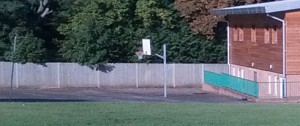
Context
Avenue Primary is a large community school situated in a suburban area of London. At the present time the school has 832 pupils, both boys and girls, with 35 teachers and 21 Teaching Assistants. By September 2016, it is planned that the school will have 932 children with almost 100 staff. 60% of the pupils are white British with the remainder from a range of ethnic backgrounds. The pupils enter the school aged three and leave at 11 years of age. It is a multicultural school in which 22.5% of the pupils speak English as an additional language. 9.3% of the pupils have free school meals which is lower than the national average. The proportion of pupils with special educational needs is also lower than average.
The school is a National Teaching School and supports other schools in need of improvement. Recently the school has supported two schools in Berkshire and Portsmouth. The school is also involved in the Schools Direct initiative which means that it trains student teachers on-site. Some teachers on the staff are 'Leading Teachers' and 'Associate Advisors' for the Sutton Local Authority. In 2012 the school received ‘outstanding’ grade in an Ofsted inspection. The inspection report said:
This is an outstanding school. Pupils flourish both academically and socially and mature into responsible members of the school and wider community. The vast majority of parents and carers who gave their views were extremely positive about all aspects of the school.
In the end 2012 tests for maths and English, 94% of the 11 year olds pupils reached level 4 and above. Level 4 is the average.
The school website states that Avenue, ‘...is a welcoming school where everyone is valued equally in a safe and supportive environment’. Pupils are encouraged to reach their potential ‘...and develop as independent learners who think carefully and reflectively’. The school is working towards becoming a Rights Respecting School which means that they will adhere to the 42 Articles of the Rights of the Child.
The Creative Connections project was carried out in two Year 5 classes (9-10 year olds). Two teachers were responsible for the project: one newly qualified fulltime teacher and the second, more experienced teacher, who shared the class with another teacher. Neither of the two teachers are art specialists. Of the two classes approximately 30% of the pupils spoke more than one language and were not born in the UK. The rest were white British and monolingual.
The Project
At the beginning of the project year the more experienced teacher agreed to carry out a pilot project with her class in order to assess the mechanics and organisation of the website. The pupils were given logins and asked to find an image which represented their impressions of Europe and write a little about this. Most of the pupils’ posts were linked to football and holiday destinations as can be seen from the two comments below:
When I think about Europe I think about football and how I love it!
This (the chosen image) makes me think of Europe because I think mostly of Southern Europe where we go on holiday and do water sports.
In November 2012 the newly qualified teacher attended the Training Day at the University of Roehampton alone as the school felt it could not release two teachers at the same time. She said that attending the training day alone was a challenge for her as she had only started teaching in the September and she had to feedback to her colleagues in school about the project. However, she achieved this successfully. As a focus for their specific project the Avenue teachers decided that they would follow one of the Images and Identity schemes of work (a link for these is on the Creative Connections website) and explore European landmarks with their pupils. The project was organised during the spring term; from January to March. Initially the pupils and teachers discussed Europe and the EU to ascertain what the pupils knew about Europe. They then explored images of different European buildings together, taken from the Creative Connections Image Bank. As one of the teachers said in her final interview:
...we used it [the Image Bank] when we looked at landmarks…. We looked at the detail, why they were designed…looking at those was great because it generated an awful lot of conversation …
The pupils were then asked to create and draw their own landmark independently. Before the children started actually drawing a great of time was spent talking about different European buildings. The children gave their designs a great deal of thought in relation to the European aspect of the design as can be seen below in Indira’s intricate design which includes human chains and fountains (Europe United). The written text reflects her vision of Europe.
Figure 2: Europe United
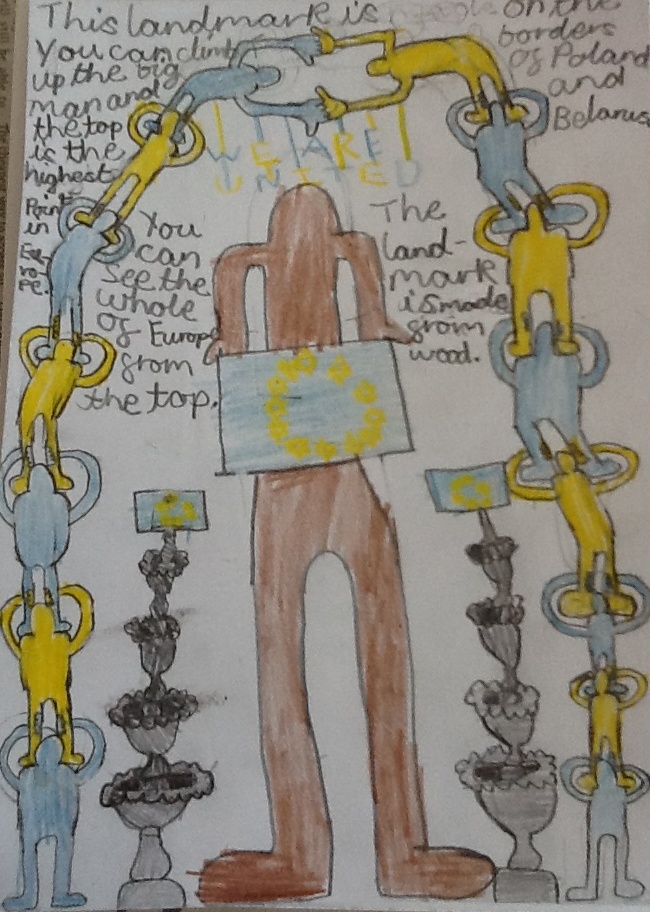
Indira’s Landmark
My picture is about how Europe is united because it has people linking hands and helping each other make an arch. It also includes two fountains because Europe has lots of fountains. My landmark is located on the borders of Poland and Belarus because they’re in the middle of Europe. You can climb up the big man and from the top you can see the whole of Europe. It is the highest point in Europe.
Two university researchers visited the classes during this phase of the project and talked to the pupils and the teachers about the aims of the Creative Connections project and gave them information about how to upload their images and responses onto the Quad Blog. The Avenue school were in QB6 with three other schools from Spain, Portugal and Finland. These pupils’ first creations were uploaded onto the QB after the half term break in February.
After the pupils had designed their individual landmarks they collaborated in groups to design a group landmark based on their individual drawings. The final stage of the scheme was to make collages of the landmarks but unfortunately there was not enough time to work on this.
In relation to ICT support and equipment, the school does not have an IT suite where classes can work together. Each class has a number of laptop computers which the pupils share. The pupils were given their own logins to the secure part of the CC site and were allowed the flexibility of visiting the site at home.
Research in action
Initially the two teachers felt that the pupils would not be able to cope with the project as there was too much for them to understand, such as the concept of European identity and designing a new European building. As one of the teachers stated:
Initially they did not understand what we were talking about but we said open yourselves up to it and think about anything you like, anything you think is not wrong, it can’t be wrong. We took them out of the box of learning in the classroom. My European identity and my artwork I can think like that. The artwork they produced was fabulous wasn’t it?
As the project developed the teachers realised they needed to be facilitators of the pupils’ learning in order to support their engagement in the project and make the pupils’ learning less teacher centred.
Although the two classes worked on the Landmark project successfully before the February half term break it seemed the teachers were reluctant to post any of the children’s work onto QB6 so by the end of February nothing had actually been posted. In reflection in their final interview the teachers said they found the website challenging. The more experienced teacher said,
It was a good site but … it wasn’t quite as media friendly as it could have been. Once you’ve done it a couple of times you would remember but you didn’t with this one.
They also said that they had problems because of the logistics of sharing the laptops between the children:
We were working with groups of six but you can’t keep on doing that (the newly qualified teacher).
However, during the February half term break one boy uploaded a poster he made and posted a comment to his Spanish peers to ask them to respond to him. This nine year old boy continued to blog throughout the project. He posted a range of images: the Shard building in London (which influenced his own landmark design); his group’s building and various responses to other images on QB6.
Figure 3 Group Building
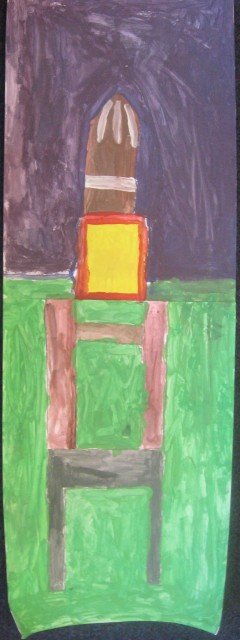
To be able to do this he said he watched the YouTube video clip posted on the Creative Connections website which gave instructions of how to download the Word Press App, which he did onto his Ipad. From doing this he had the freedom to post whenever he wanted. This, he usually did at home. During the rest of the project his fellow classmates became aware of his range of postings and some even commented about his postings in their final evaluation of the project.
From the Easter break the children’s work was uploaded onto QB6. The pupils responded to their classmates’ work and occasionally pupils from the other schools responded to their work which the teachers said they particularly enjoyed: ‘They loved …the whole process.’ However, both teachers felt that it was disappointing that this communication between the different classes did not happen more. The following two images and written texts are examples of the posted work:
Figure 4 Eloise’s Landmark
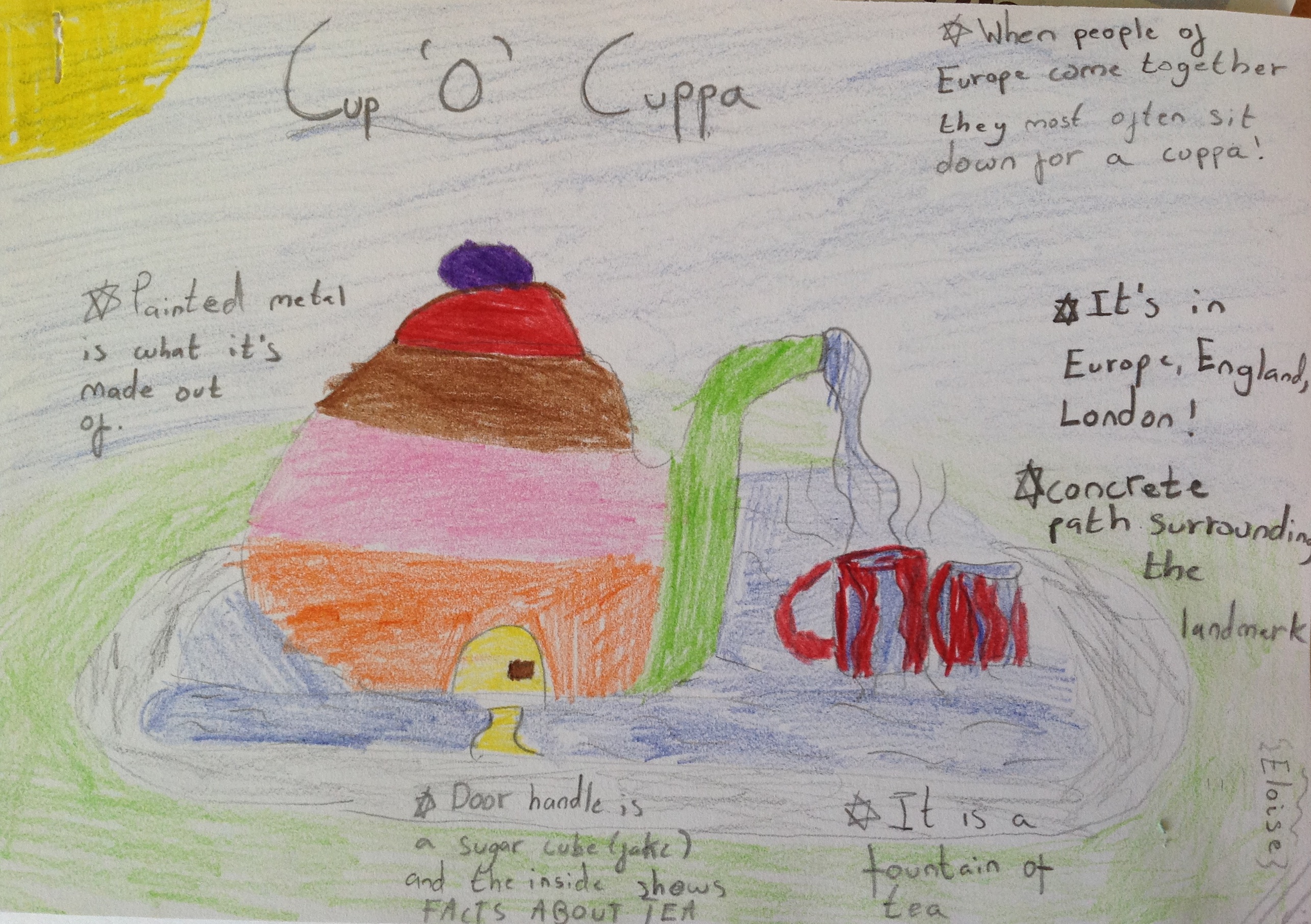
This is my landmark, cup ‘o’ cuppa. When I think of Europe, I think of us all coming together for a cup of tea. There are two cups to represent lots of us. The many colours represent that there are many European people. I HOPE THAT YOU LIKE IT. Ask any questions.
Figure 4 Iffat’s Landmark
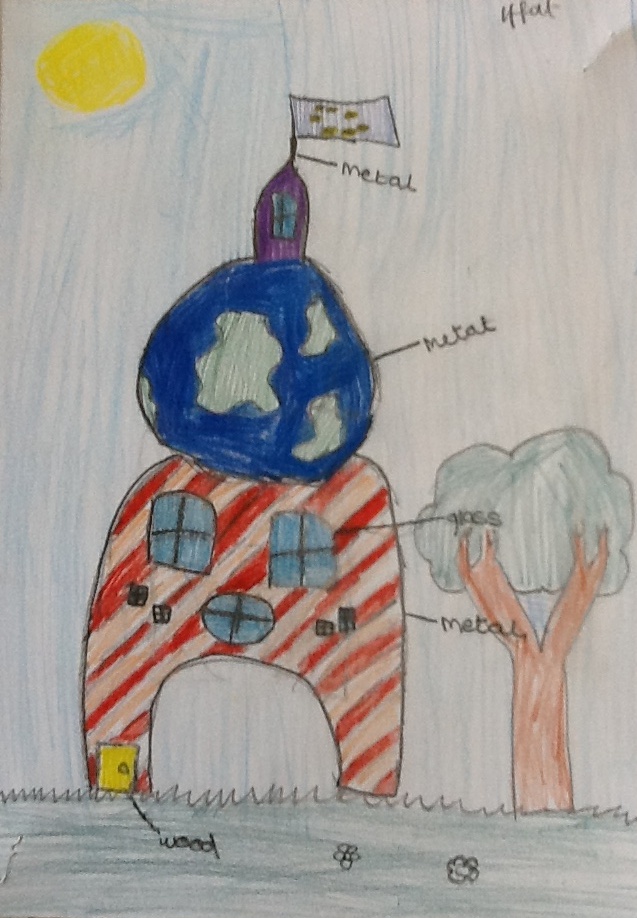
In my picture the world represents Europe and inside you can see all the countries in Europe. At the top it has a gigantic European flag which shows that it’s a European statue.
Interestingly the children’s responses to each other were often short and to the point, such as:
Nice drawing:
I like it, it is very good:
Hi Iffat, it’s Chicho .I like your pic it’s how did u do it nice and pretty.
During her final interview one teacher surmised that these short phrases could be linked to the pupils’ knowledge of social media sites such as Facebook:
They might have thought this was something similar to something like Facebook and Twitter. It’s very chatty, not quite the same the content as writing in class.
However, both teachers said the discussion around the project in class was consistently rich and varied but this had not translated into the writing on the Quad blog.
In relation to the pupils’ developing understanding of their European identity both teachers admitted that initially they thought the pupils’ would struggle with this concept but the project had made the pupils’ implicit knowledge of Europe explicit. The pupils became more interested in their European peers and many said in their evaluation of the project that they wanted to learn more about Europe. Some pupils made comments about the interesting artwork of their European peers. Liam, the first blogger, was so interested in the look of the Catalan language that he copied and pasted a Catalan post into a file on his Ipad. Indira, whose cultural heritage is Indian, had a long discussion with her teacher as she felt she was not European even though she had been born in the UK. As her teacher said:
We then had a fabulous discussion on this, I said you are living in England and England is in Britain and Britain is in Europe. As we talked she said I suppose that we trade together and we get things from Europe. I then asked if she then felt part of Europe and she said yes as she gets things from Europe. I think a lot of the children hadn’t really thought about being part of Europe, Indira just verbalised it more.
Pupil Voice
The pupils very much enjoyed working on the European landmarks project. They initially worked individually and then in groups. They enjoyed the creative freedom that the teachers gave them as they worked in their individual landmarks, as one boy said: ' you could just imagine any landmark' and another said ' you were left to do it all by ourselves.' This freedom was not normal as usually they said they were guided more in creating their art. They were also pleased to see their work posted onto the Quad Blog, as one said 'I'm proud of my work on the project' and many children showed their parents the Quad Blog.
The connections that the pupils made through the blog impacted on their views not only of Europe but also the art that their European colleagues created. Views such as:
Initially I thought it would be boring but some of the art work was cool and represented their countries.
Here it can be seen that each pupils’ perceptions were changed through the project. Other pupils realised the link with other European peers’ identity through the artwork:
Creative Connections was fun, making friends through their art: you're in yours and they're in theirs.
As well as the different variety of styles they were able to see:
It's a good way to see different countries’ artwork, what they can do, different ideas which represent a country.
One boy spoke of a specific image he liked because of the technique of making the picture using little squares.
The pupils were very positive about the whole process of the project, they enjoyed blogging and the use of machine translation. The children made comments such as:
The blogging and translation allowed us to talk to others.
They appreciated the automatic machine translation and said it was 'so clever'. They were also aware of their vulnerability in relation to the web, and as one boy said about his experience:
It is a really good project because you can get in touch with people you don't even know and you know it is safe.
They also felt a stronger connection with each other:
The project has brought us closer together.
The pupils all responded to learning about Europe through the project, as Sara, a bilingual girl of Asian heritage, said so very clearly:
I always thought that Europe wasn't anything to do with me but this has made me think we are European.
The children's awareness was raised through the website as it showed them 'What is important about Europe and what is different'. Interestingly they talked about working and linking with children of their own age:
We are all children, they are different to us and they may like the same things, like chocolate and ice cream but they also have cultural food that we don't have.'
and, as another child said, the project:
… made me realise how close we are to other Europeans.
Teacher Evaluation
In a mid-project interview, the less experienced teacher stated that she was concerned about the time the project had taken and how difficult it was to schedule the project into the demands of the weekly timetable. However, when she was interviewed with her colleague after the project had ended her reflections were much more positive. She felt that:
The children were freer and more creative than in normal art lessons.
She also very much enjoyed the cross-curricular aspect of the whole project in that it linked many areas together. The second and more experienced teacher said she had learnt a great deal and stated:
I think that’s what has come out of it for me, don’t under estimate them (the pupils). They can take an awful lot more than you think they can.
She said that she would definitely use the Creative Connections methodology again because she realised the level of challenge that teachers could give to pupils.


